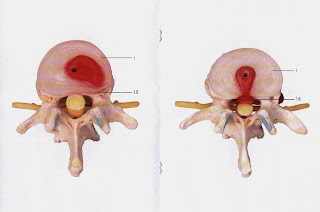 The disc is the material that lies between the vertebrae. Its purpose is to separate the bones from each creating spaces or openings where the spinal nerves can exit the spinal cord and branch to the muscles and organs. This discs also act like shock absorbers to the spine since they consist of a gelatinous collagen substance as well as water.
The disc is the material that lies between the vertebrae. Its purpose is to separate the bones from each creating spaces or openings where the spinal nerves can exit the spinal cord and branch to the muscles and organs. This discs also act like shock absorbers to the spine since they consist of a gelatinous collagen substance as well as water.
To get an idea of how much force this is, consider that it only takes about1000 N to knock out a heavyweight boxer.
When a disc ruptures, it is typically very painful, so much so that patients initially have difficulty just sitting upright or standing.
If the herniated disc is in the lower back, or lumbar spine, it can cause pressure on the spinal nerves, sending pain down the legs, known as sciatica, since that is where the nerves are traced to. Lower back pain is certainly to be expected as well.
If the herniated disc goes posterior, it can press up against the spinal cord, and if this occurs in the lumbar region, can cause bowel and bladder incontinence.
Some of the patients that we see with herniated discs have already had surgery. Sometimes we can help them, other times we cannot. If there surgery included stabilizing rods and screws, then there is little we can do for their discomfort. This is because you don’t want to risk loosening the hardware that is meant to stabilize the injured region.
If a herniated disc occurs in the neck, arm tingling, numbness and weakness may accompany it, along with the obvious, neck pain. This is because a group of nerves together, known as the brachial plexus, may become irritated. The brachial plexus is the group of nerves that supplies motor and sensory function to the upper extremities.
Aside from surgery, people may try steroid injections. While they help a lot with the pain reduction, it is only temporary, with the average relief span between 2-6 months.
Most people usually take medications, since it is least invasive and helps a little. After a while, they may need to take more just to knock the pain down. At some point, they may consider surgery.
Several years ago, a new procedure known as spinal decompression therapy was successful in getting the nucleus pulposus back to the center of the disc. Chiropractic care offices have been instrumental in bringing this technology to the forefront.
It has helped several people in our office avoid having surgery. For those fortunate ones, they cannot say enough positives about the procedure.
Still, for others, their condition was too far gone for it to be of benefit. We currently can help 3 out of 4 patients, or about 75% of the patients with spinal decompression for disc herniations. That’s a really good percentage, and certainly worth it considering the alternatives.
Thank you.
Pingback: Penelope Hodge